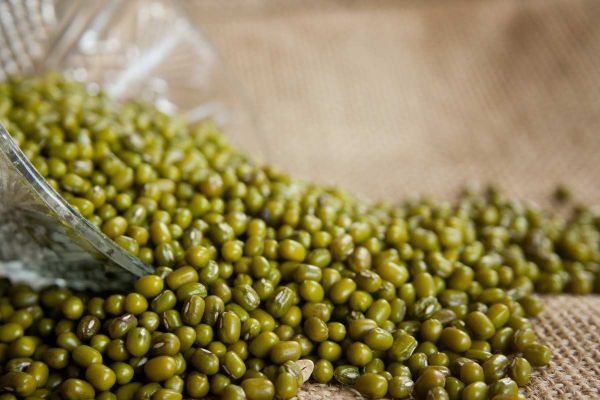Green Gram Seed Germination, Time Period, Process
Green Gram Seed Germination, Time Period, Process

The Green gram is also called as moong, mung bean, is one of the most important short-season, summer-cultivated legumes. Green gram seed germination can occur after a period of dormancy and is affected by available light, water, air, and many other variables. Sprouted Green gram seed is an excellent source of low-fat protein and fiber. It is rich in digestive enzymes, antioxidants, vitamins, and minerals.
In this article we also discussed below topics;
- How do you germinate Green gram seeds
- Green gram seed germination temperature
- How do you germinate Green gram seeds
- How long does Green gram seed take to germinate
- Process for germinating Green gram seeds
- Green gram seed germination period
A step by step guide to Green gram seed germination
Green gram is an important legume crop extensively cultivated in many developing countries. Green gram sprout production is a simple germination process that requires neither sunlight nor soil; it has no season limitations. The germination process is completed in just 4 to 8 days. The sprout production is extremely inexpensive, requiring Green gram seeds, sprouting containers, and water as inputs. Then, it can be practiced even by poor farmers in augmenting their meager resources. Green gram sprouts serve as a good alternative vegetable and source of income. This is particularly true during the hot wet summer and rainy seasons when there is an acute shortage of fresh vegetables, or in the event of crop losses.
Different varieties of Green gram
SSL 1827 – This is made by cross-breeding with Green gram and Rice bean. It gives an average yield of about 5.0 quintal/acre.
ML 2056 – This variety is suitable for the Kharif season. Gives average yield of about 4.5 quintals/acre.
ML 818 – This variety is suitable for the Kharif season. Gives average yield of about 4.9 quintals/acre.
PAU 911- This is suitable for the Kharif season. Gives average yield of 4.9 quintals/acre.
SML 668 – Suitable for summer sowing and ready to harvest in 61 days. Gives average yield of about 4.5 quintals/acre.
SML 832 – Suitable for summer sowing and ready to harvest in 62days. Gives average yield of about 4.6 quintals/acre.
Other varieties are;
Jawahar – 45 – Gives average yield of 4-5.2 quintal/acre.
ML 1 – Ready to harvest in 90 days and gives an average yield of 3-4 quintal/acre.
Pusa Baisakhi – Ready to harvest in 60-70 days. Gives average yield of 3.2-4 quintal/acre.
Mohini – Ready to harvest in 60-70 days and gives an average yield of 4-4.8 quintal/acre.
PS 16 – Ready to harvest in 60-65 days and gives an average yield of 4 – 4.8 quintals/acre.
Selection of Green gram seeds
Seeds used for sowing should be from an authentic source. An authentic source is one that proves the genetic purity and also other aspects of seed quality of seed being sown. Seeds used for sowing must be vigorous, only then you can expect a good field stand. Seeds should be checked for hard seeds, diseased seeds, immature seeds, shrunken, deformed, and off-colored seeds.
Seed quality is important for the germination process. First, choose premium grade seeds of medium size and smooth seed coats. Also, remove broken and shriveled seeds. Be sure that seeds are not treated with fungicides or insecticides. Small hard-seeded Green gram often has poor germination and weak sprout growth. Large-seeded Green gram is also not so economical since they result in lesser sprouts. Store Green gram seeds under cool and dry conditions to ensure high seed germination and sprout vigor. Green gram seeds stored under 0ºC and 85% relative humidity produce good quality sprouts. Seeds with 15% moisture could be safely stored for one year at 10ºC or below.
The decrease in the quality of Green gram seeds is usually caused by the change of relatively high protein and fat content in the seeds, increasing the moisture content of the seeds if the temperature and humidity of the storage environment are high. This decrease in quality is a gradual and cumulative procedure of deterioration in viability, and cannot be reversed due to physiological and biochemical changes. The procedure of decreasing seed viability cannot be stopped but might be slow down to get a longer shelf life. The rate of chemical change in seeds during the storage period is influenced by mainly two factors, internal and external factors. The internal factor is related to the characteristics of the seed that influence germination, a genetic trait called physiological decline. The external factor is related to seed packaging, storage temperature, and humidity which are called physical factors and biological causing damage to the seeds such as bacteria, fungi, and insects.
Green gram seed preparation
Because the major use of Green gram is for sprouts; excellent germination must be maintained by careful harvesting and storage systems. Green gram seed is not generally treated with fungicides, insecticides, or bactericides because of the possibility of ingestion of treated seed. Because the seed is small, careful handling and attention to planting machinery adjustments are essential to ensure planting with little damage to the seed.
If Green gram is being planted in a field for the first time the proper nitrogen-fixing bacteria must be provided. These inoculants can be applied to the seed just before planting or applied in the furrow in peat. Care should be taken to distribute these inoculants uniformly in the field. Be sure to use the bacteria that are specific for the Green gram or closely related species. Only certified seed must be used so that quality and variety purity are guaranteed.
The seed rate and seed treatment of Green gram
The seed rate varies with seed size and growing season. Depending on the Green gram variety the seed rate varies from 8-10 kg per acre.
Before sowing, shrunken, shriveled, fungal infested, and bruchid infected seeds should be removed and only good seeds must be sown. Sometimes hard seeds occur in some varieties due to initial seed dormancy. Such a variety of seeds should be identified and treated with commercial sulphuric acid.
Seeding date and seedbed preparation of Green gram
The soil must be tilled to remove weeds and to prepare a seedbed that will provide good seed-soil contact. The final seedbed needs to firm with a surface free of clods and then debris to allow a good distribution of seeds. If moisture is short, keep preplant tillage to a minimum to prevent drying out the top 2 or 3 inches.
Green grams should be planted between May 15 and June 6 like the other legumes (field bean, adzuki, and cowpea) which are being grown as the major crop on the field. Too late a planting date results in bloom and then pod fill during the hottest, driest period of the summer season. In some areas Green gram is planted as a second crop after the small grain is harvested. If this is done planting occurs immediately after the grain harvest with a minimal disturbance of the seedbed.
Seeding method of Green gram
Seeds should be planted 1 ½ inch deep in a well-prepared seedbed with good moisture content. If the surface layers are dry this depth can be increased to 3 inches if the soil type is one which does not crust easily. The seedlings of a Green gram can have a hard time breaking through a thick crust and stands will be reduced.
The seed germination time and temperature of Green gram
The optimum temperature range for growth is 27°C and 30°C. This means that the Green gram crop is usually grown during summer. Seed can be planted when the minimum temperature range is above 15°C. Green gram seeds are responsive to daylight length.
The seed germination time will be 4 to 5 days; though, the actual rate of seed germination varies according to the amount of moisture introduced during the germination stage. Watering the bean seeds every 4 to 5 hours results in faster germination.
Washing and soaking of Green gram seeds
Wash the seeds in freshwater, stirring vigorously 3 to 4 times to allow the empty, broken, and light seeds to float. Remove the floating seeds and debris. Then, repeat washing using fresh water every time until the beans are thoroughly cleaned. Commercially, earthenware and stone jars are used for sprouting seeds. These types of containers have holes near the bottom to drain out excess water. For a larger quantity of seeds, use germination tanks of convenient size, and preferably lined with tiles. Wash containers thoroughly with hot water about 80ºC before use. Big plastic containers will also do.
After washing, soak the Green gram in tap water at room temperature for eight hours. In the cool season, use warm water about 32ºC for soaking. Put the soaked beans in containers and do not fill the containers to more than 75% of their capacity to avoid overflowing when the seeds sprout. Apply a fine water spray or mist uniformly over the seeds at 3 to 4-hour intervals during the hot season and 6-7 hours during the cool season. Then, apply just enough water to keep the sprouts continuously moist without drying. An overhead water pipeline fitted with taps and movable water pipe or an automatic sprinkler system connected to a timer is convenient for watering.
The sowing time and method of Green gram seeds
The sowing process is done on the onset of the monsoon in Kharif season and during the second fortnight of February to the first fortnight of March in the summer season. Sowing must be done behind the local plow or with the help of a seed drill.
Green gram plant distance or the spacing of Green gram seed
Planting should occur early enough that harvest will occur before the rainy season and soil temperature ranges are above about 15°C. Two plantings annually, one in spring and another in fall, are possible in warmer regions. Though, tilling or cultivating the top several inches of soil breaks up the ground and controls weeds. Green gram seeds germinate best when planted 1 to 2 inches deep in moist soil. One seed every 3 inches in rows 18 to 24 inches apart provides an adequate crop yield. The seeds are sown at 2 cm depth with a plant to plant spacing of about 10 cm and 30 cm between rows.
The process of Green gram seed germination
The germination begins with water absorption, and followed by significant chemical changes, including the interconversion of compounds. During sprouting, a large portion of the original nutritional value of the Green gram seeds is retained, and the amounts of some active substances increase significantly.
Dig one end of the row to the depth of shovel, put that soil at the other end of the row, and then loosen the soil at the bottom of that space another shovel-blade deep. Then, dig the space next to that, putting the removed soil in the first space. Continue digging down the row and loosening the soil at the bottom of each hole until you put the first soil you removed at the other end of the row. This extra-deep row will allow the roots of the Green gram, which can reach 24 to 30 inches deep to more easily, reach their potential. This procedure is known as double digging. Do this in an area of the garden that receives full sun when it is dry enough to work in the spring.
Lay several Green gram seeds from each variety you plan to plant on separate damp paper towels. Roll the towels up and then seal them in plastic storage bags. Put the bags in a warm place out of the direct sun and check the seeds daily after a week has passed, looking for green sprouts to emerge from the end. Viable Green gram seeds germinate in 7 to 14 days. A germination test is very important if the seed is from an unfamiliar source or is old.
Test the soil temperature level in late spring with a soil thermometer. If you don’t want to buy a soil thermometer, stand in the prepared soil in your bare feet for 5 minutes. If your feet don’t get cold, the soil has warmed to about 21°C. The optimal soil temperature for green beans to germinate is between 21 and 26°C. Below 15°C the seeds can take more than 2 weeks to germinate and may rot before they do if conditions are wet.
Rake the soil smooth in a prepared row, chopping up any soil clumps. Sow the Green gram seeds 6 inches apart and 1 inch deep, slightly less if you have clay soil. Water in well, keeping the soil moist, but not soggy until the Green gram seeds germinate.
Sprout production of Green gram seeds
Beans begin to swell after 8 hours and begin germinating after one day. Green gram seeds germinate fully 2-3 days after soaking with 1-2 cm long sprouts. Sprouts attain a length of about 5 cm or more in 4 to 5 days of soaking. In most countries, the standard marketable sprouts are at least 5 cm long. Sprouts grow farther, reaching a length of about 8-9 cm after 6-8 days of soaking.
Green gram seeds cultivated for sprouts benefit from different treatment than seeds planted in the ground as a garden plant or field crop. Seeds for sprouts are washed, and then soaked in water at 32°C for 2 to 4 hours or in the water at room temperature overnight before being rinsed and placed in a sprouting container. A porous cushioning pad located on top of the seeds with a lightweight on it encourages thick yet tender sprouts. A sprouting temperature between 21 and 26°C ensures the best quality sprouts within 4 to 5 days. When temperatures are between 26 and 29°C, sprouts grow slightly faster but are thinner. Sprinkling water over the sprouts every 4 to 6 hours for the first four days, then increasing intervals between watering to 8 hours is ideal.
Posted
2 years ago
No comments yet! Why don't you be the first?










Add a comment